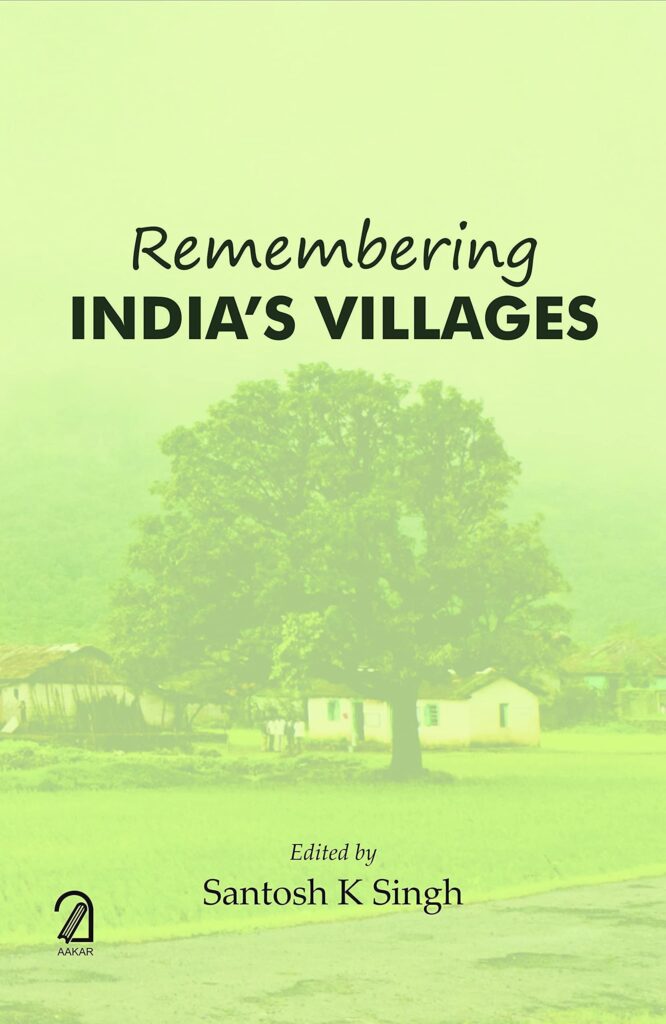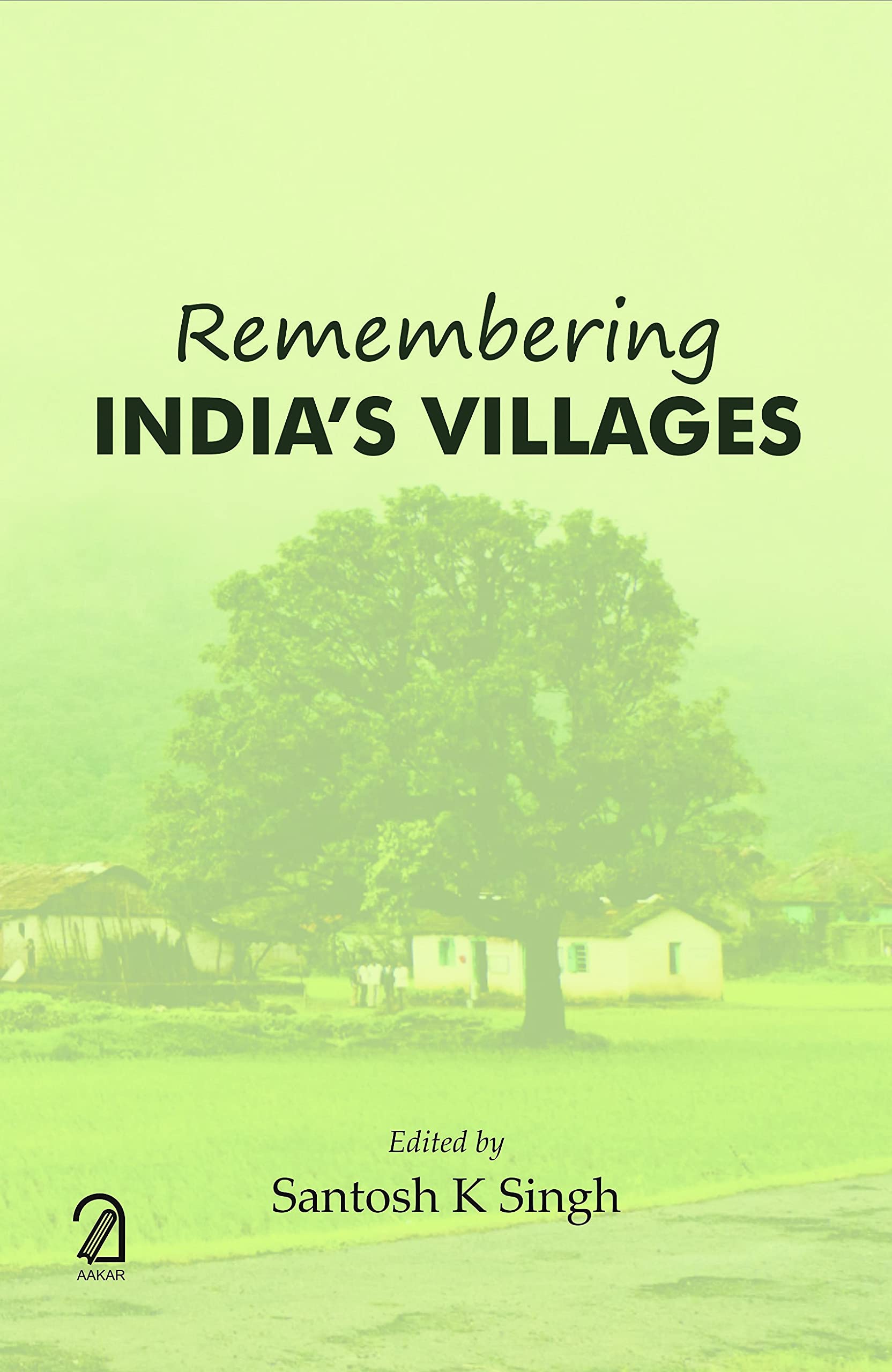
Remembering India’s Villages, edited by Santosh K. Singh and published by Aakar Books in 2021 is a compilation of research articles. Most of these are based on fieldwork that seeks to bring back the attention of scholars and policymakers on Village India. It traces the changes in our perception of the village over time to reinstate the significance of ‘village’ as an idea and a concept that helps us understand Indian society. The unitary objective of the authors in the book is to urge us to think of a village beyond both-the romantic and the depressing, the sceptical and the merely utilitarian points of view. Since, villages are complex socio-cultural spaces and not just economic units, as Santosh Singh notes.
Before we discuss the contents of the book, we should ponder why villages stopped being a matter of academic concern not only in scholarly literature but also in the classrooms. I presume that the more university and elite institutions are dominated by urban-bred students, not only do they choose topics that predominantly belong to the urban world, but also academic programs tend to ignore courses on the rural to cater to them. So, this is also an issue of the composition of students in educational institutions because prospects in academic careers demand a focus on the urban. However, it is a pitfall trying to study the urban without adequately understanding the rural for they are intrinsically connected, related, and dependent on one another. This book serves as a reminder of the continued significance of the rural, resisting its abandonment in an increasingly urbanized world and times.
Dev Nath Pathak’s article juxtaposes the thoughts of Gandhi and Tagore and brings out a certain ‘critical romantic utopianism’ they shared to assess their positions vis-a-vis Ambedkar’s critique of the caste-based social order of the village. I would recommend reading Bidhan Chandra Dash’s article about violence against Dalits right after Pathak’s so one would understand why Ambedkar did not have any hopes for the emancipatory potential of Indian Villages. Although Pathak’s essay gives us three vantage points to look at how villages were perceived, positionality matters. Gandhi and Tagore still spoke from positions of privilege whereas Ambedkar spoke from disprivilege. That is why I see Dev Nath Pathak’s attempt in bringing them together as far-fetched.
While Dalit lives in villages tell us how oppressive rural spaces have been, the views and voices of women are also yet to be properly incorporated into the social sciences. Ishita Mehrotra maps the occupational patterns of a U.P village and argues that modernity is not necessarily an oppositional force or a counterposition to traditions, rather capitalist pursuits that drive modern society are based on the exploitation of traditional hierarchies. She gives an account of women’s place in the system especially Dalit women to expose its top-down approach and exclusionary tendencies. Despite playing a prominent role in the rural economy and agriculture in particular, women are often invisiblized. Not only does Shalini Bhutani’s essay highlight this for us but it also talks about the politics behind genetically modified seeds and the increasingly dominant role played by MNCs and the State in its pricing decisions. State intervention, technological advancement, intellectual property rights and the legal battles it ensues have so far only favoured the corporate forces and not Sammamma – a representative of Bhutani’s rural women in the field. She calls for the re-localization of food and farming and agro-biodiversity in seeds and greater policy focus on women because sustainable means to overcome the predicament imply ecologically and socially just solutions.
Ishita Dey recommends multi-species ethnography as an alternative to shifting gears from macro to micro perspectives, the dynamic and intertwined relationship between humans and non-humans to explore deeper into rural ecology where there is so much to talk about the role of the ‘non-human’ in human social life. She points out how early anthropological works influenced British officials in the way they understood and governed villages. Handed-down colonial notions dominate the anthropology of Indian villages such that human life continues to take centre stage and the studies remain anthropocentric. Dey calls for multispecies ethnography to encompass the non-human and their dynamic relationship with the human in the world they share. This species-turn in anthropology, she believes, would help a located anthropologist imagine a village as an interspecies locatedness in the global space where creatures other than humans shape social relations, especially their dependence on forests. Multispecies ethnography, for instance, can help us understand Adivasi lives better. Or serve as a useful method in the hands of students coming from Adivasi communities to represent their lives beyond the anthropocentric worldview imposed upon them. Such attempts indicate new and unexplored vistas that pertain to human-nature connections: the role of rivers, biospecies and the other environmental factors that sustain human lives on earth. Anjana John and Sukhwant Sidhu, in their chapters, on energy distribution and social consequences of state policy respectively, draw our attention to scarcely explored areas such as infrastructure in rural areas.
Bhavya Chitranshi and Anup Dhar address the problematic that the rural is traditional, precapitalist and backward whereas the urban is modern, capitalist and developed. Both the rural and the urban are rather complex social units consisting, as the authors put it, ‘mutual and dynamic constitutivity’; They situate the village as the ‘world of the third’ in the circuits of global capital. In the process, they attempt to reverse the gaze and see the uninfluenced fragment of the rural from the capitalist society as a potential ground for the future. That is the world of the third- away from the first and second world of capitalism- cocooned in the rural that is yet to be decrypted.
Priyanka Kaul takes us into the world of Bollywood and annotates the way Hindi cinema represented villages, its people, and their lifestyle- sometimes merely as a backdrop to its narrative. Yet, the village always had some ‘metaphoric significance’ in Hindi cinema presenting it sometimes as exotic, otherwise as arcadian and belonging to the yesteryears. In recent times, Indian villagers are often typecast as dubiously savage. Thus, Kaul traces these shifts in the narrative from the village as an authentic site of India (romantic) to one of exploitation and vulnerability (critical) indicating its corresponding shift in perception of an Indian village both due to social changes such as migration and mobility and critical awareness over oppressive forces.
Chandri Raghava Reddy and Prashanth Kumar Munnangi talk about how scientific knowledge marginalized community knowledge in cultivation after the green revolution. Cultivation for commercial purposes where agricultural productivity is a key concern has led to greater dependence on ‘knowledge-based’, and ‘technology-intensive’ agricultural production. While indigenous knowledge of agriculture is sensitive to the ecological health at large, modern scientific practices are driven by profit-seeking market forces that are obsessed with greater yields and higher productivity. The authors affirm that indigenous knowledge is polyvalent given its comprehensive focus on cultivation whereas singular stress on better yields makes modern agricultural practices monovalent. The desire for upward mobility has compelled farmers to adopt knowledge and technology-based new agricultural practices where they struggle to keep up with up-to-date technology. Small and marginal farmers could not compete with the big farmers who could understand and implement modern techniques better. Thus, farmers at large are caught up in a ‘web of risks’ including their local knowledge systems being displaced. Yet as the author notes, senior farmers continued to preserve traditional cultivation techniques. But there is a caveat: agriculture remains an entitled occupation of the upper castes and hence passing down of ‘traditional knowledge’ in agriculture would mean the inheritance of cultural capital within these castes. Therefore, we need more clarity on how indigenous knowledge is to be understood and its implications for marginalized communities.
Santosh Singh’s essay talks about how agriculture was never merely an economic activity but its various aspects- such as land, tools, seeds, and grains were treated with reverence. Agriculture was part of the sacred realm and hence various rituals were practised. Thus, one would blunder looking at agriculture outside its sociocultural significance. Stating why he deems agricultural practices so important, Singh reasons that they determine even ‘the normative structure’ of a society, say its food habits and preferences. This religio-sacred character of agriculture demarcated the line between what is grown for profit and what is cultivated for household consumption. Hence, the people of the village, he studied looked at agribusinesses with disdain. He affirms through the article that local and cultural contexts also shape people’s choices rather than profit motive and economic reasoning alone.
The underlying message of the book is that there is more to Village India than what cinema portrayed to us, than what we were made to believe by the governments, its policymakers and even the intellectuals amidst us. There is a need to introspect about what shaped our popular perception and cynical attitude towards the village to get a fair picture. These thought-provoking chapters in the book question our preconceptions of village societies and help us revisit and reimagine them. The book propounds that Village India-which still provides for two-thirds of our population cannot merely be the past that we abandon but could even be our future if only we seek to reimagine them. Yet, it remains unclear how we can envision this future towards the rural and if so, will those who continue to suffer get to live with dignity and equal opportunity there? Can we ensure that? The book did not raise those concerns. These questions keep cropping up and keep us warned that any revivalism without equality and social justice will undermine our struggle against feudal forces so far.
This book is most suitable for postgraduate students, and researchers in the social sciences particularly those interested in the topics mentioned above, but not limited to them. It will serve as a useful resource for classroom discussions, dissertations, and rural development practices as well.
***
Saravanan Velusamy is a PhD candidate with the Center for the Study of Social Systems (CSSS), Jawaharlal Nehru University (JNU), New Delhi.
